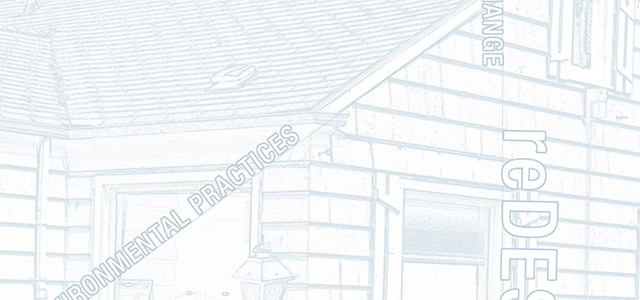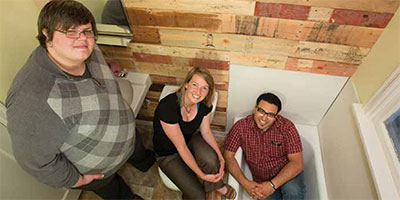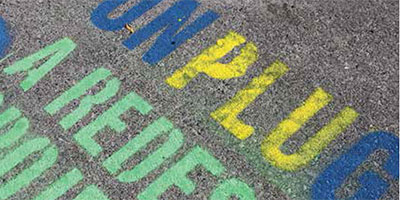
reThinking how sustainability is taught at PLU using a novel approach at reDesign House.
The art of sustainability
Across the street from the Martin J. Neeb Center sits an old house – not built to the exacting LEED environmental standards of Neeb, but being remodeled as an expression of the possibilities of sustainable practices at PLU.
At first glance, it’s difficult to see the differences between this house and the many other ramblers that dot the neighborhood. But take a closer look and the differences come to light. Rain barrels on each corner of the exterior collect water from the gutters to be repurposed elsewhere. The paint on the exterior of the house makes rainwater bead up, and when it drips off, it naturally washes dirt from the house.
There are big plans for this PLU-owned property, called the “reDesign House.” The goal is to take this vacant single-family residence and turn it into a creative space where students, faculty and staff can work together to experiment with sustainable environmental practices in a real, physical space.
But the reDesign House is more than just a place to experiment with sustainable living practices. It is also an emblem of a holistic approach that blends environmental practices and social change with the disciplines of art and design.

Lace Smith, Chrissy Cooley and JP Avila in the reDesign House. (Photo by John Froschauer)
“The eventual goal is to have a space that is a learning laboratory,” Sustainability Manager Christine Cooley said. “One that is about serving our community with what it needs, not what you think it needs.”
It all started back in 2008, when the campus community began thinking about how to best explain and promote the idea of sustainability. PLU has committed to becoming carbon neutral by 2020.
Departments across campus started thinking about how they might implement carbon neutrality. Cooley, along with Associate Professor of Graphic Design J.P. Avila and Lace Smith, assistant director for technology and social media in Student Involvement and Leadership, had the idea to bring together students from disciplines that are sometimes not associated with sustainability and see how they might be able to effect change.
“It’s a paradigm shift,” Cooley said. “It can’t be captured in one major. I think you should find your own interest within sustainability.”
The first step was led by Smith, who hosted a workshop with students to help them identify their worldview. The exercise was based on the social change model – how social justice is defined for the individual, in groups and in the world.
They asked the question: “How does privilege play a part in art, social justice and sustainability”?
From there, the group worked on defining what a course focused on the issue of sustainability would look like, and how such a class could work across disciplines.
The next step was offering an art class that focused on social change and sustainability. The first class took place in the fall semester of 2012, taught by Avila and Smith. The course leveraged the skills of art students to help market and express efforts of sustainability on campus.
“It was design for social change,” Avila said.
For art students, that meant finding ways to best communicate and illustrate the ins and outs of sustainability. During the course, the students worked toward promoting an annual challenge at PLU – unPLUg. The event challenges different residence halls to cut the amount of energy they consume in a given month. To get the word out, the students focused on chalk advertising, putting different messaging in chalk drawings – including a chalk mural – throughout campus.

During UnPLUg students meet the challenge to reduce their energy consumption from the previous year.
That proactive approach made sense for Krista Fredricks ’13, who received her BFA in graphic design this past May. “As a designer, I know that I have the power to make a difference with what I create,” Fredricks said. “Sustainability is an important issue and I wanted to help make an impact and create a stronger presence for it at PLU.”
She and the other students did exactly that. By the end of the first week, the energy usage rate had already dropped by 30 percent from the previous year.
It was part marketing, part outreach and part behavior change.
“The students in the Sustainability Office were shocked,” Cooley said. “It completely changed how the sustainability office operates.”
It also reaffirmed to the three campus leaders that their efforts in approaching sustainability in a multidisciplinary manner worked.
“When one group breaks the mold, everyone else is like ‘Hey, we can do this,'” Smith said.
This past spring, those involved with reDesign House began to examine how other students with different skill sets should be brought into the process. In addition, they are developing a proposal for how the coursework they’ve developed fits into the PLU curriculum. As the development of the reDesign House continues, Smith, Avila and Cooley expect more collaboration
with students and faculty, as they see how sustainability can be a resource
for other majors at PLU.
“We never thought of it as just an art and design course,” Avila said.
“It’s contagious in a very good way,” Smith added, “because at the end of the day we’re trying to build a better Lute.”


